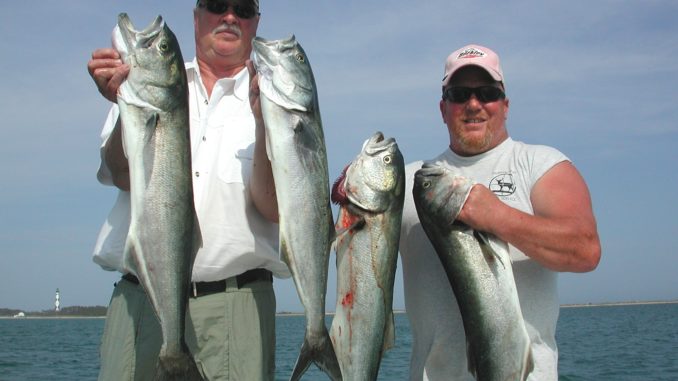
Bluefish (Pomatomus saltatrix) are nearshore pelagic fish found around the world in temperate and subtropical waters, with the exception of the northern Pacific Ocean. They range in size from 7-inch snappers to large fish found primarily from Cape Hatteras north that are called “chopper” or “Hatteras” blues.
Bluefish have bluish green upper backs that fade to gray/silver down their sides to a white belly. Their nicknames come from their mouth full of pointed, sharp teeth that are always willing to clamp down on anything in their range.
Up to around three pounds, bluefish travel in large schools. They are very aggressive and may attack anything their size or smaller; questions have been raised as to how large a fish or animal they might attack. Fishermen have long joked about schools of wildly feeding bluefish being the saltwater counterparts of piranha.
As they grow larger, bluefish abandon large schools and live in smaller groups that might more correctly be called packs. They feed on schools of forage fish and occasionally attack ruthlessly in a frenzy called a “blitz.” The Outer Banks are famous for blitzes when packs of bluefish chase many species of fish through the surf zone unto the beach.
The current world and state record is a 31-pound, 12-ounce fish that was caught at Cape Hatteras in 1972 by James Hussey of Tarboro.
Bluefish are primarily a recreational fish in United States waters, but commercial fisheries exist in some areas. Bluefish populations were determined to be at an all-time low in 1996, and aggressive management measures implemented in 2001 led to the stocks being declared rebuilt in 2007, three years ahead of schedule in a 10-year plan. Bluefish rank second to striped bass as the most-harvested recreational species in the Mid-Atlantic.
Opinions vary as to the table quality of bluefish. The meat is light blue-gray and is a little stronger. Bleeding larger fish and removing the dark strip of meat on the sides helps mellow the flavor. Smaller bluefish eat small minnows and crabs, and most fishermen agree they have a milder flavor.
The method of preparation affects the flavor of all fish. Frying adds oil, and baking or broiling removes it. Smoked bluefish is a favorite of many who don’t care for it prepared otherwise. The opinions are skewed towards those who talk disparagingly about the table quality of bluefish, but many people enjoy it.



